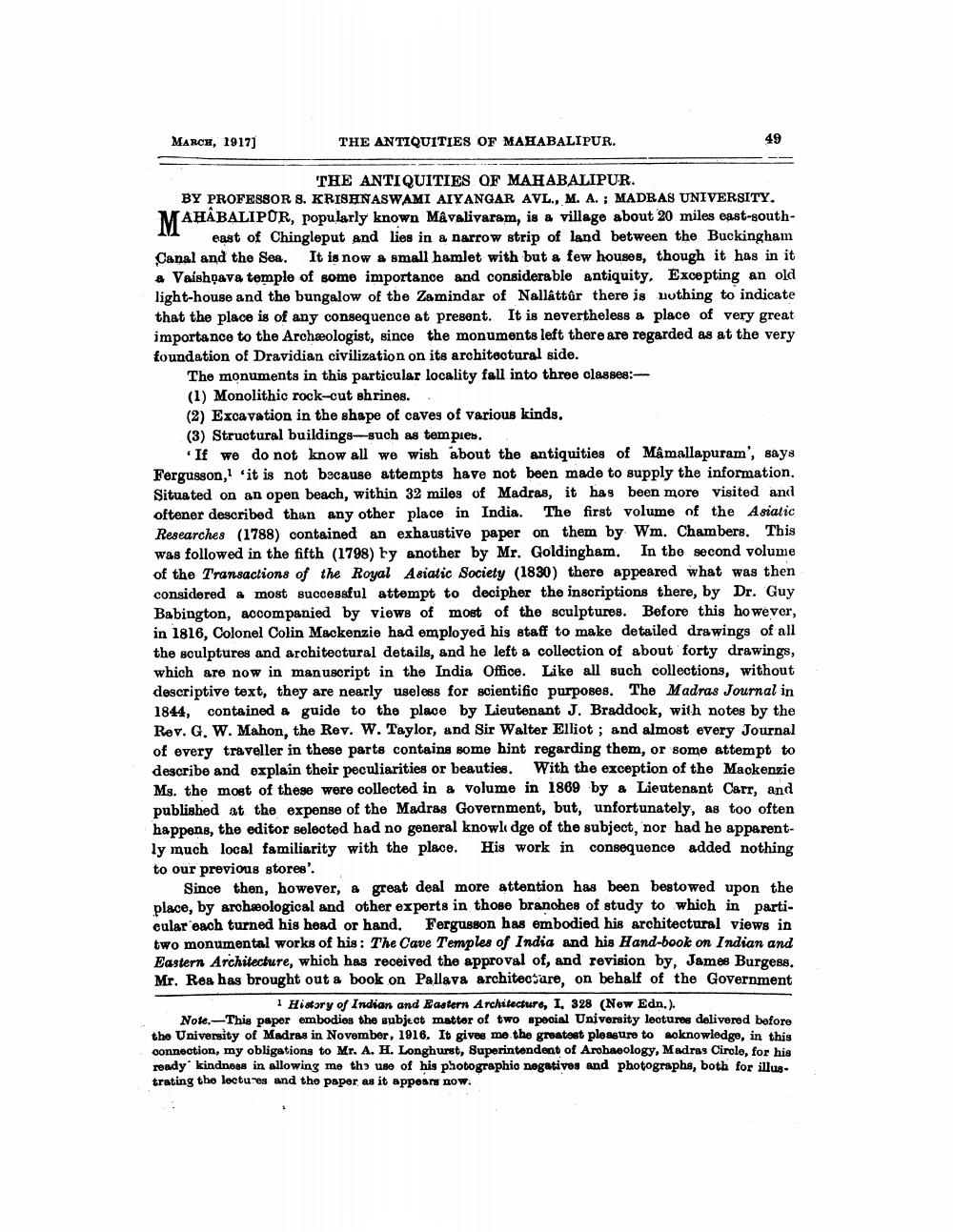________________
MARCH, 1917)
THE ANTIQUITIES OF MAHABALIPUR.
THE ANTIQUITIES OF MAHABALIPUR. BY PROFESSOR 8. KRISHNASWAMI AIYANGAR AVL., M. A. ; MADRAS UNIVERSITY. MAHABALIPOR, popularly known Mâvalivaram, is a village about 20 miles east-south
east of Chingleput and lies in a narrow strip of land between the Buckingham Canal and the Sea. It is now a small hamlet with but a few houses, though it has in it a Vaishọava temple of some importance and considerable antiquity. Excepting an old light-house and the bungalow of the Zamindar of Nallattor there is nothing to indicate that the place is of any consequence at present. It is nevertheless a place of very great importance to the Archæologist, since the monuments left there are regarded as at the very foundation of Dravidian civilization on its architectural side.
The monuments in this particular locality fall into three classes: (1) Monolithic rock-cut shrines.. (2) Excavation in the shape of caves of various kinds, (3) Structural buildings-such as tem pies.
If we do not know all we wish about the antiquities of Mamallapuram', says Fergusson, it is not because attempts have not been made to supply the information. Situated on an open beach, within 32 miles of Madras, it has been more visited and oftener described than any other place in India. The first volume of the Asiatic Researches (1788) contained an exhaustive paper on them by Wm. Chambers. This was followed in the fifth (1798) by another by Mr. Goldingham. In the second volume of the Transactions of the Royal Asiatic Society (1830) there appeared what was then considered A most successful attempt to decipher the inscriptions there, by Dr. Guy Babington, accompanied by views of most of the sculptures. Before this however, in 1816, Colonel Colin Mackenzie had employed his staff to make detailed drawings of all the sculptures and architectural details, and he left a collection of about forty drawings, which are now in manuscript in the India Office. Like all such collections, without descriptive text, they are nearly useless for scientific purposes. The Madras Journal in 1844, contained a guide to the place by Lieutenant J. Braddock, with notes by the Rev. G. W. Mahon, the Rev. W. Taylor, and Sir Walter Elliot; and almost every Journal of every traveller in these parts contains some hint regarding them, or some attempt to describe and explain their peculiarities or beauties. With the exception of the Mackenzie Ms. the most of these were collected in & volume in 1869 by a Lieutenant Carr, and published at the expense of the Madras Government, but, unfortunately, as too often happens, the editor selected had no general knowledge of the subject, nor had he apparently much local familiarity with the place. His work in consequence added nothing to our previous stores'.
Since then, however, & great deal more attention has been bestowed upon the place, by archaeological and other experts in those branches of study to which in partieular each turned his head or hand. Fergusson has embodied his architectural views in two monumental works of his: The Cave Temples of India and his Hand-book on Indian and Eastern Architecture, which has received the approval of, and revision by, James Burgess. Mr. Roa has brought out a book on Pallava architecture, on behalf of the Government
History of Indian and Eastern Architecture, I. 328 (New Edn.). Note. This paper embodies the subject matter of two special University lectures delivered before the University of Madras in November, 1916. It gives me the greatest pleasure to acknowledge, in this oonnection, my obligations to Mr. A. H. Longhurst, Superintendent of Archaeology, Madras Cirole, for his ready' kindness in allowing me thouse of his photographio negatives and photographs, both for illustrating the lectures and the paper as it appears now.




